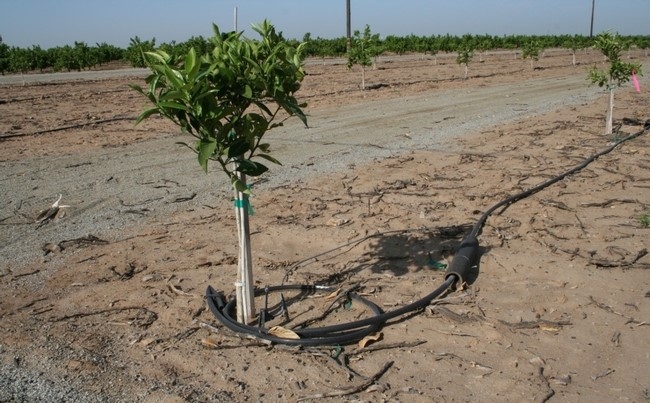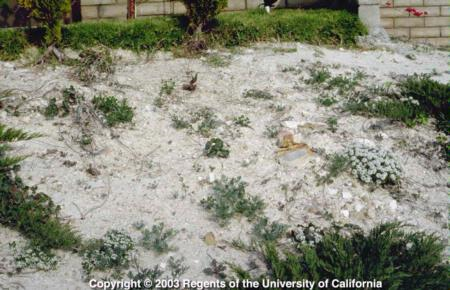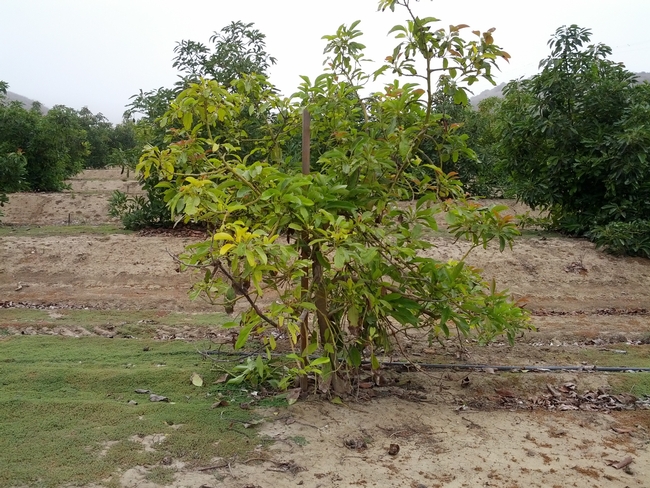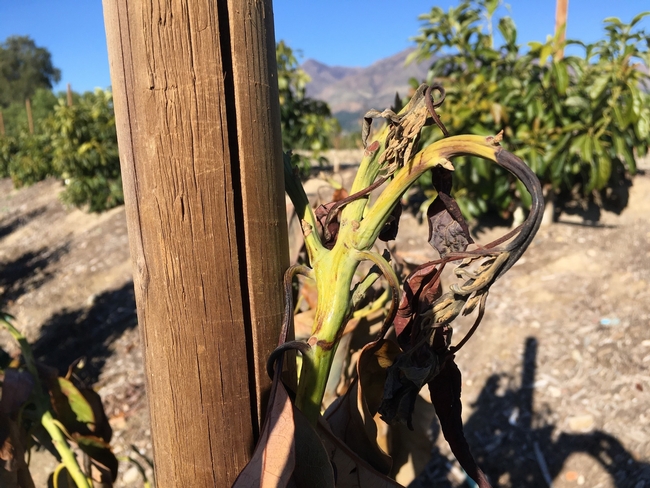
Posts Tagged: pH
Why Test Soils?
Because it is easier to correct a problem before you plant the trees than it is to diagnose and treat dying ones, which will probably be ripped out. A sad start to a tree is not a good ending.
In general, soil analysis is a measure of the physical, biological and chemical environment that a tree is going to be growing in. Is there going to be an impeding layer? Is it a waterlogged area prone to asphyxiation? A heavy soil that is going to need berming? Is it going to be too steep to harvest? These are physical properties that stand out and need to be considered.
Biological properties are harder to assess, but looking for old root channels and how healthy the previous crop grew are good indications of good biological health. How are those weeds growing?
The chemical side is often viewed from the nutritional and the toxicity angles. Trees are able to store nutrients in their various organs and have aids like mycorrhizae to help them take up some nutrients. So it's best to actually test the tree to see what their nutrient status is. Leaf analysis becomes the guide.
We do soil chemical analysis in trees primarily to identify potential toxicities. And for avocado trees, the main toxicities are high pH, salinity, sodium and chloride. Especially pH, which they like between 6 and 7. If it is corrected before the tree goes in the ground, it's relatively easy and inexpensive to correct. Once the tree is the ground, it takes a long time and energy and often it's hard to correct it without the tree dying. Like a waste of time and energy. But hey, I got the trees coming and it's time to be bold and act!! Let's plant.
And usually about a year after the tree is in the ground, the leaves start turning yellow and the canopy starts thinning. The tree was loaded up with iron in the nursery and after being in the high pH ground, it could not get enough iron and iron chlorosis set in. Well get ready to spend the next few years correcting the pH without killing the tree with sulfur or spending the rest of the tree's life messing with iron chelates. It would have been easy to apply a sufficient amount of sulfur in the planting area before planting, waiting for the sulfur to lower the pH, then planting.
Salinity, chloride and sodium are also important for testing prior to planting. Normally we think of these as chemicals that move with rainwater and irrigation. But in years when we have no rain, that doesn't happen. The light sprinklings we have can just move these salts a few inches into the ground and when trees are planted the salts migrate into the root zone. Even when berms are built and soil is scrapped into a hill, it's the surface soil that is being scrapped where all the salts are.
This situation can be compounded where there have been raspberry tunnels or flower tunnels previously and there has been no rain touch the ground the whole time the ground was covered. Or, where there was a crop with a high level of nutrients being applied and there could be levels high enough to affect the salt sensitive avocado. If you know salts are high, the soil can be leached before the trees are planted.
The effect of salt on the young trees can be almost immediate, within a week after planting. It can be dramatic and shocking.
Measuring sodium, chloride and salinity should be ongoing throughout the production years of an avocado. The status of the sodium, chloride and salinity are a reflection of how irrigation water is being managed. Is it getting enough, frequently enough? Was there enough rain to start the irrigation season without leaching?
Yeah, soil needs to be tested on a frequent basis. But the cheapest test and the easiest correction is done before planting. Do it.
Controlling Soil pH with a Grass?
This is an intriguing article that popped up about how to improve blueberry production in alkaline soils. High pH soils are a major issues for many of our tree crops along the coast. pH is what controls the availability of most plant nutrients and what bacteria and fungi grow in the soil, creating the biosphere. So can growing a grass cover crop in our orchards improve lemon and avocado production?
A lawn is better than fertilizer growing healthy blueberries
Intercropping with grasses is an effective and sustainable alternative to chemical treatments for maximizing blueberry yield and antioxidant content in limey soils.
Blueberries are prone to iron deficiency - and correcting it increases their health-enhancing antioxidant content, researchers have discovered.
Published in Frontiers in Plant Science, their study shows that growing grasses alongside blueberry plants corrects signs of iron deficiency, with associated improvements in berry quantity and quality. The effects are comparable to those seen following standard chemical treatment - providing a simpler, safer, cheaper and more sustainable strategy for blueberry farming on sub-optimal soils.
What do superfruits eat?
All soils are rich in iron, but nearly all of it is insoluble.
"Most plants get enough iron by secreting chemicals that make it more soluble," explains senior study author Dr José Covarrubias, Assistant Professor of Agriculture Sciences at the University of Chile. "These iron 'chelators' can be released directly from the roots, or from microbes that grow among them, and allow the iron to be absorbed."
"Blueberries, however, lack these adaptations because they evolved in uncommonly wet, acid conditions which dissolve the iron for them."
As a result, most of the world's relatively dry or alkaline ('limey') cropland is unsuitable for optimal blueberry growth.
"Iron is essential for the formation and function of plant molecules like chlorophyll that allow them to use energy," Covarrubias continues. "That's why iron deficiency shows up as yellowing leaves - and drastically reduces plant growth and yield.
"And in blueberries, iron-dependent enzymes also produce the 'superfruit' antioxidants responsible for their celebrated blue skin and health-enhancing effects."
Strong blueberries must pump iron - but at what cost?
There are two approaches to correcting iron deficiency in blueberries: acidify the soil, or add synthetic iron chelators. Each has its drawbacks, says Covarrubias.
"The commonest industrial approach is soil acidification using sulfur, which is gradually converted by soil bacteria into sulfuric acid. The effects are slow and difficult to adjust - and in waterlogged soils, hydrogen sulfide might accumulate and inhibit root growth.
"Acids can also be added directly via irrigation systems for more rapid acidification - but these are hazardous to farmers, kill beneficial soil microbes, and generate carbon dioxide emissions.
"A commoner strategy among growers is application of iron bound to synthetic chelators - often sold as 'ericaceous fertilizer' - but these are very expensive and leach potentially toxic chemicals into the water table."
A cheaper, safer alternative is needed for efficient large-scale blueberry production. Thankfully, one already exists.
"Grasses - which are well-adapted to poor soils - can provide a sustainable, natural source of iron chelators via their roots when grown alongside fruiting plants. Intercropping with grass species has been shown to improve plant growth and fruit yield in olives, grapes, citrus varieties - and most recently, in blueberries."
A grassroots approach to sustainable blueberry farming
Now, Covarrubias and colleagues have brought intercropping a step closer to the mainstream of blueberry cultivation.
For the first time, they measured the effects of different methods of iron chelation on antioxidant content and other fruit qualities in blueberries.
"In an orchard of 'Emerald' blueberry bushes cultivated in alkaline (pH 8) soil, we compared the effects of five different iron chelation treatments: a 'gold-standard' synthetic iron chelator (Fe-EDDHA), intercropping with grass (common meadow grass or red fescue), cow's blood (Fe-heme), or no treatment (control)."
"We found the association with grasses increased not only the total weight and number of blueberries per plant, but also the concentration of anthocyanins and other antioxidant compounds in their skins, compared to control. The effect sizes were comparable with the proven synthetic chelator Fe-EDDHA, whereas applications of Fe-heme from cow's blood - a fertilizer commonly used in home gardens - had no significant effect."
The beneficial effects paralleled improvement in the plants' iron status (leaf color), which was also comparable between the grass-associated and the Fe-EDDHA-treated plants. None of the treatments had a significant effect on average berry weight
Turf is ready to roll out for healthier blueberries
A potential limitation of intercropping observed in the study was a decrease in berry firmness, since firmer berries are favored by consumers.
"The association with grasses decreased berry firmness compared with control plants, whereas the berries collected from plants treated with Fe-EDDHA reached intermediate values.
"However chemical analysis showed a non-significant trend towards increased ripeness in the berries collected from the intercropped plants, which could account for this small difference."
Intercropped plants also required an additional water supply to maintain a similar soil moisture to other treatments, but plant management was otherwise straightforward and the same across groups. The grasses were kept cropped between 5 and 15cm - a typical range for an attractive mown lawn.
"Our findings validate intercropping with grasses as a simple, effective, sustainable alternative to standard iron correction strategies in blueberries," concludes Covarrubias. "Both commercial and private growers can put this strategy to use right away to boost their blueberry crop and antioxidant content."
###
Please link to the original research article in your reporting: https://www.frontiersin.org/articles/10.3389/fpls.2019.00255/full
Frontiers is an award-winning Open Science platform and leading Open Access scholarly publisher. Our mission is to make research results openly available to the world, thereby accelerating scientific and technological innovation, societal progress and economic growth. We empower scientists with innovative Open Science solutions that radically improve how science is published, evaluated and disseminated to researchers, innovators and the public. Access to research results and data is open, free and customized through Internet Technology, thereby enabling rapid solutions to the critical challenges we face as humanity. For more information, visit http://www.frontiersin.org and follow @FrontiersIn on Twitter.

soil colors
Soil and Water pH Affect Root Health in HLB Citrus
At the recent HLB Conference in Florida a paper was given that reinforces the need for appropriate soil and water pH to maximize root density and tree health. The industry there is dominated by a range of rootstocks and by Valencia-like varieties. Jim Graham and colleagues have shown that pH contributes to orchard health in their HLB situation. This should be a reminder for California growers for general tree health. Florida soils tend to be more coarse than soils found in many California orchards. It's much harder to change soil pH with acidified irrigation water with heavier textured soils.
4.b.1 Soil and water acidification sustain root density of huanglongbing-infected trees in Florida
Jim GRAHAM, Kayla GERBERICH, Diane BRIGHT, Evan JOHNSON
University of Florida, Citrus Research and Education Center, Lake Alfred, Florida, USA
Abstract: Early symptoms of HLB include fibrous root loss and leaf blotchy mottle, followed by premature fruit and leaf drop, and yield decline. As a consequence of initial bacterial infection of fibrous roots, a 30-50% reduction in fibrous root density and elevated soil Phytophthora populations were detected in field surveys. Continued sampling of Hamlin and Valencia orange trees on Swingle citrumelo rootstock in different stages of HLB decline revealed that root loss occurs in two stages. The second phase of root loss (70-80%) begins at the early stage of tree canopy thinning resulting from leaf drop and branch dieback. A more extensive survey of HLB-affected groves indicated that greater decline in fibrous root health and expression of HLB symptoms is observed where irrigation water is high in bicarbonates (> 100 ppm) and/or soil pH > 6.5. HLB symptom expression of trees on different rootstocks follows the known intolerance to bicarbonate (Swingle citrumelo > Carrizo citrange > sour orange > Cleopatra mandarin). Acidification of irrigation water in central ridge and south central flatwoods Valencia orange groves on Swingle citrumelo rootstock for three seasons has maintained soil pH below 6.5 on the flatwoods and 6.0 on ridge. Over the last three seasons of survey, root density as an index of root heath has been sustained. Phytophthora populations remain below the damaging level in ridge groves and in flatwoods increase to damaging levels coincident with the fall root flush but drop back to non-damaging levels for remainder of the season. Compared to the 2013-14 season, yields in the ridge blocks have increased up to 4% and on the flatwoods have increased up to 22%.Growers using acidification treatments with sulfuric and/or N-phuric acid for the last 3 seasons report an average cost of $60 per acre. This cost will analyzed in relation to yield response to provide a cost benefit of acidification
Non-Technical Summary: Managements have been implemented to reduce soil, nutrient and water stress, and Phytophthora root rot. They include frequent irrigation cycles, fertigation and acidification of irrigation water and soil to reduce rhizosphere pH, and fungicides. Root density of trees under these practices fluctuates seasonally and annually but has not declined over the past 3 years. Trees managed with soil acidification and fertigation have steadily recovered in health and yield.
http://www.icc2016.com/images/icc2016/downloads/Abstract_Book_ICC_2016.pdf

citrus
Soil pH Reduction with Organic Amendments
Soil pH along most of the California coast north of Los Angeles ranges between 7.3 and 8, which is generally higher than many edible and ornamental plants prefer. In some cases, availability of micronutrients such as iron is severely limited in soils above pH 8, leading to deficiency symptoms in plants. Other plants such as blueberries, rhododendrons, azaleas, and hydrangeas prefer acidic soil conditions (pH 6 and below).
To investigate potential soil pH reduction over time, UCCE Farm Advisors Jim Downer and Ben Faber applied coffee grounds, lemon waste, peat moss, pine needles, oak leaves, and municipal yardwaste in addition to elemental sulfur to soil with an unadultered pH of 7.8.
Preliminary findings indicate that the combination of organic material plus elemental sulfur reduces pH to a greater degree and more quickly than either the amendment or sulfur alone. We have seen the greatest effect thus far with elemental sulfur plus coffee grounds, chipped lemon waste, or peat moss. the long term trend so far has been none of the organic amendments alone have affected pH much. Traditionally it has been thought that oak leaves, pine needles and coffee grounds should have a significant effect on pH. It does not seem to be the case.
Lemons that are to be ground and spread
Spread coffee grounds

lemon waste

coffee grounds
Calcareous Soil Confusion
Calcareous soils have often more than 15% CaCO3 in the soil that may occur in various forms (powdery, nodules, crusts etc…). They are relatively widespread in the drier areas of the earth. California is notable for its young soils, that is, soils that have a relatively high level of nutrients because low rainfall means that natural productivity has not been leached out. The potential productivity of calcareous soils is high where adequate water and nutrients can be supplied. Water is the most limiting input to making California soils productive.
The high pH associated with these soils, though, is not the level of calcium present. It is the carbonate in the soil or the bicarbonate associated with the waters found in those soils which controls the pH. The high pH then controls the availability of iron, zinc, manganese and copper. These nutrients need to be added as foliars or soil applied, or better yet, the soil pH needs to be dropped to around 7 to make these nutrients available.
Recently someone asked if replacing the calcium with potassium would change the pH. No, it won't. The carbonate needs to be removed. Calling it a calcareous soil confuses people about what caused the high pH. The carbonate or bicarbonate needs to be removed with acidification, it turning it into CO2 gas. This is done with urea sulfuric acid or sulfuric or sulfurous acid. There are actually magnesium dominated soils in the San Luis Obispo area that have high pHs due to carbonates. They are carbonateceous.

calcareous soil


